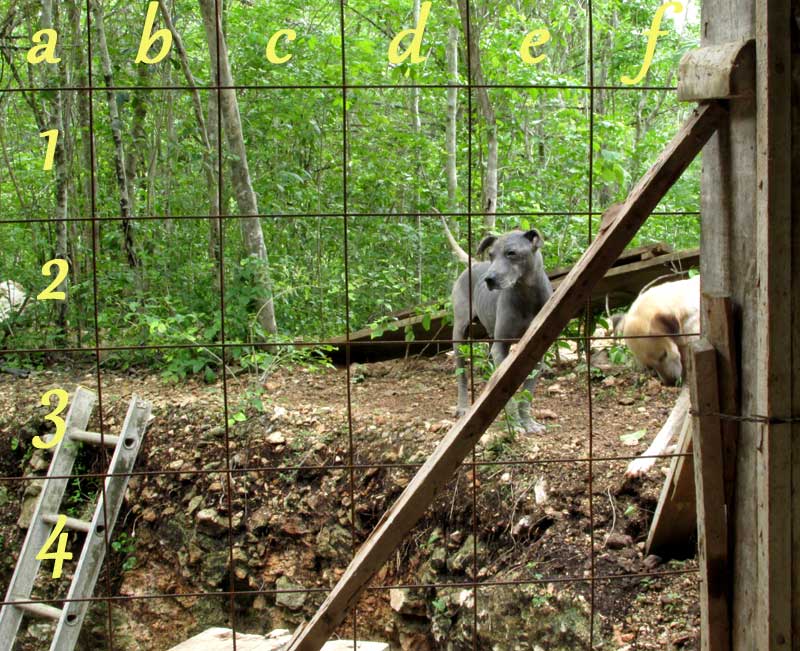
An Excerpt from Jim Conrad's
NATURALIST NEWSLETTER
June 11, 2017
Issued from Rancho Regenesis near Ek Balam ruins 20kms north of Valladolid, Yucatán, Mexico

The rancho owner became concerned that the dogs and I might some night take a wrong step and plunge into the deep pit beside and partially underlying the hut's "porch." A wire fence was erected at the porch's edge. The fence's crisscrossing wires, six inches from one another (15cm), formed a visual grid through which I could view the world beyond from my desk. You can see the effect at the top of this page.
That picture bears numbers and letters along the side so I can draw attention to specific parts of the picture framed by the fence's wire grid. For example, the face of the black dog, Chichan 'Cho', appears in block e-2.
It seemed a good idea to label the grid squares because as soon as the fence was set up and I began seeing things through the gridwork, I was powerfully struck by this fact: Every block in the grid was worth studying in detail. In fact, any block turned out to be more interesting and of greater aesthetic value as the whole scene itself.
Chichan 'Cho''s alert face at e-2 is worth admiring. He's just heard another dog down below bark and he's wondering whether he needs to start barking himself. Just look at his tail so utterly at attention at d-2. Katrina's face at f-3 is just as much focused on her flea situation, as she nibbles at a shoulder. But, these dog features might even be noticed without the grid. The grid is especially good for focusing us on parts of the scene that normally the eye passes by, and the mind ignores.
For example, just look at the lush, green foliage at d-1. That block of visual details is a symphony of a forest being itself, busy at work photosynthesizing carbohydrate for itself as it blesses the biosphere with pure, breathable oxygen. What's missing in that block view is the leaves' animation as a light breeze passes through the forest. And the calls of the Melodious Blackbirds, Turquoise-browed Motmot and White-tipped Dove that at that moment happened to be filtering through those very leaves. After my mind has inhabited D-1 awhile, I feel at peace, I feel that things here are doing fine, everything is in order, even when I know that the larger scene gives a very different impression.
The blocks around D-1 also show forest, but each one is a little different, maybe with a tree trunk cutting through it, or maybe the block is more or less shaded, or displays some kind of disruptive element. The process of slowly, deliberately moving the mind from one surrounding block to the next produces the effect of there being a forest symphony progressing over time, a sharp or a flat here or there, sometimes a little discordance or surprising chords, fortes and diminuendos, all so very agreeable.
C-4 is a study of the pit's geology. I've studied the pit's walls for hours, for in some places the wall was clearly cut through limestone deposited millions of years ago at the bottom of a shallow sea, but in other places you see mixed rocks and dirt, as is the case with C-4. My guess is that the ancient Maya leveled the top of the mound the hut sits on, and C-4 shows rubble they carried up here. We're only about 5kms from the important ruins of Ek Balam, so it's to be assumed that building occurred here, and we know the Maya liked to place their huts atop mounds.
But, even without the archaeological angle, on at aesthetic level, C-4 is simply a pleasure to look at, an abstraction conveying a certain feeling, sensations based on rocks being angular, not rounded, on their being of different sizes, not all the same, on speculation about the slightly reddish hue at the block's bottom, on and on.
So, our human minds are configured so that most, maybe nearly all, of what we sense is ignored, and this is good. It's one of the mind's most striking and useful features, an adaptation enabling us to focus on the scorpion at our feet without being distracted by the rustling of each and every leaf in the forest.
Still, grid-looking suggests that sometimes it's good to pay attention to what the mind is programmed to overlook. Grid-looking reminds us that the way we feel and behave is based on what we notice of the world around us, and we do have the power -- and maybe the responsibility -- to choose which of the world's vivid details we notice.